2019 MERCEDES-BENZ EQC SUV battery
[x] Cancel search: batteryPage 181 of 629
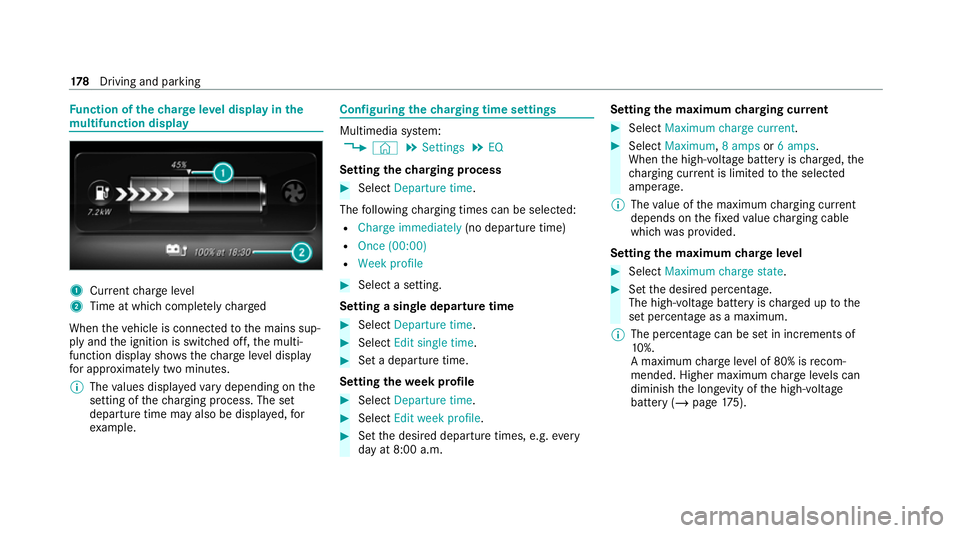
Fu
nction of thech arge leve l display in the
mu ltifunction display 1
Current charge level
2 Time at which comple tely ch arged
When theve hicle is connected tothe mains sup‐
ply and the ignition is switched off, the multi‐
function display sho ws thech arge leve l display
fo r appro ximately two minutes.
% The values displa yedva ry depending on the
setting of thech arging process. The set
departure time may also be displa yed, for
ex ample. Configuring
thech arging time settings Multimedia sy
stem:
4 © 5
Settings 5
EQ
Setting thech arging process #
Select Departure time .
The following charging times can be selec ted:
R Charge immediately (no departure time)
R Once (00:00)
R Week profile #
Select a setting.
Setting a single depa rture time #
Select Departure time . #
Select Edit single time . #
Set a depa rture time.
Setting thewe ek profile #
Select Departure time. #
Select Edit week profile. #
Set the desired departure times, e.g. every
day at 8:00 a.m. Setting
the maximum charging cur rent #
Select Maximum charge current. #
Select Maximum, 8 ampsor6 amps .
When the high-voltage battery is charge d, the
ch arging cur rent is limited tothe selected
amperage.
% The value of the maximum charging cur rent
depends on thefixe dva lue charging cable
which was pr ovided.
Setting the maximum charge level #
Select Maximum charge state . #
Set the desired percentage.
The high-voltage battery is charge d up tothe
set percentage as a maximum.
% The percenta gecan be set in increments of
10 %.
A maximum charge leve l of 80% is recom‐
mended. Higher maximum charge leve ls can
diminish the long evity of the high-voltage
battery (/ page175). 17 8
Driving and pa rking
Page 184 of 629
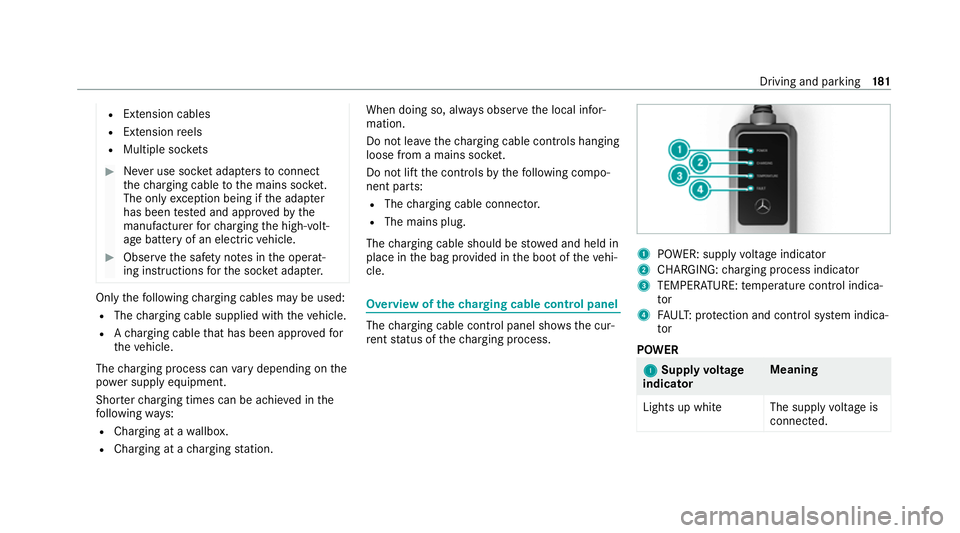
R
Extension cables
R Extension reels
R Multiple soc kets #
Never use soc ket adap ters to connect
th ech arging cable tothe mains soc ket.
The only exception being if the adap ter
has been tested and appr oved bythe
manufacturer forch arging the high-volt‐
age battery of an electric vehicle. #
Obser vethe saf ety no tes in the operat‐
ing instructions forth e soc ket adap ter. Only
thefo llowing charging cables may be used:
R The charging cable supplied with theve hicle.
R Ach arging cable that has been appr oved for
th eve hicle.
The charging process can vary depending on the
po we r supp lyequipment.
Shor terch arging times can be achie ved in the
fo llowing ways:
R Charging at a wallbox.
R Charging at a charging station. When doing so, alw
ays obser vethe local infor‐
mation.
Do not lea vethech arging cable controls hanging
loose from a mains soc ket.
Do not li ftthe controls bythefo llowing compo‐
nent parts:
R The charging cable connec tor.
R The mains plug.
The charging cable should be stowed and held in
place in the bag pr ovided in the boot of theve hi‐
cle. Overview of
thech arging cable control panel The
charging cable control panel sho wsthe cur‐
re nt status of thech arging process. 1
POWER: supply voltage indicator
2 CHARGING: charging process indicator
3 TEMPERATURE: temp erature control indica‐
tor
4 FAUL T:protection and control sy stem indica‐
tor
POWER 1 1
Supply voltage
indicator Meaning
Lights up whit eThe supplyvoltage is
connec ted. Driving and parking
181
Page 186 of 629

Setting
the maximum permissible charging
cur rent forch arging at a mains outlet *
NO
TEDanger due toexcessive charging
cur rent If
th ech arging cur rent is too high, the fuse
could be tripped or theex tern al mains supply
could overheat. #
Make sure, that theex tern al mains sup‐
ply has been designed tohandle the set
ch arging cur rent. #
If necessa ry,re duce the set charging
cur rent or use a di fferent mains soc ket. #
Before charging at a mains outlet, ha vethe
maximum permissible charging cur rent for
th ere leva nt mains outlet or the building
inspected byaqu alified electrician. The
ch arging cable supplied is set toa countr y-
specific maximum charging cur rent value.
When charging abroad, the maximum value
may exceed the permitted value forth at countr
y.When abroad, obser vethe count ry-
specific la wswhen charging.
If yo u ha vequestions concerning setting the
ch arging cur rent or if there is a malfunction,
please conta ct aqualified specialist work‐
shop. #
Set the maximum permissible charging cur‐
re nt in the multimedia sy stem menu
(/ page 178).
If th eex act value of the maximum permissible
ch arging cur rent cannot be set, select the next
smaller adjus table value.
% Ifth eve hicle requ ires more time than usual
to charge the high-voltage batter y,ch eck the
maximum charging cur rent settings in the
multimedia sy stem menu. Note
s oncharging the high-voltage bat tery
at a wallbox (mode 3) &
DANG ER Risk of fata l injury from incor‐
re ctly ins talled component parts
Connecting thech arging cable tothewa llbox
via an incor rectly ins talled wallbox or by
means of adapt ers,extension cables or simi‐
lar could cause a fire or an electric shoc k. #
Only connect thech arging cable to a
wa llbox that:
R Has been proper ly installed and
R Has been inspec tedby aqu alified electri‐
cian #
For saf etyre asons, on lyuse charging
cables that ha vebeen tested and
appr ovedby the manufacturer for
ch arging the high-voltage battery in an
electric vehicle. #
Never use dama gedch arging cables. #
Do not connect thech arging cable toan
amplifier. Driving and parking
18 3
Page 187 of 629
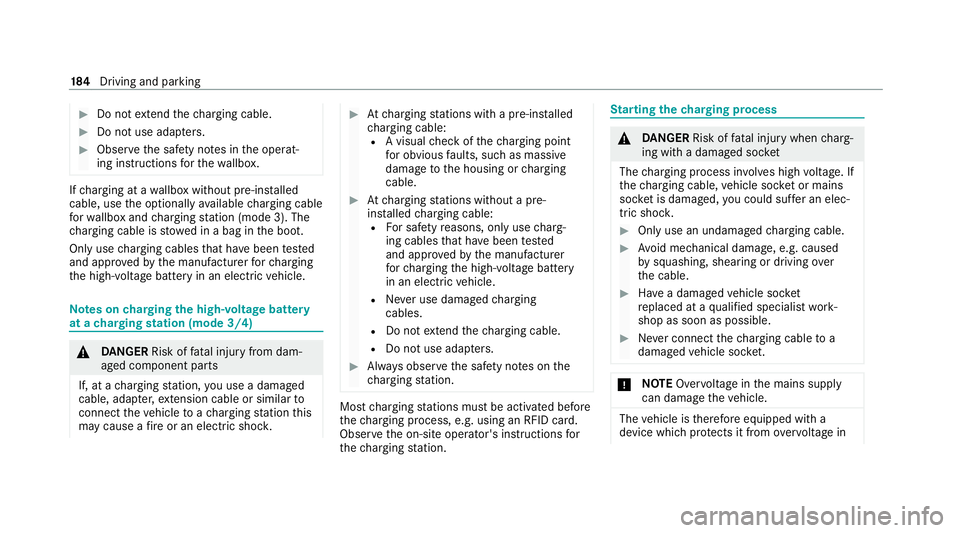
#
Do not extend thech arging cable. #
Do not use adap ters. #
Obser vethe saf ety no tes in the operat‐
ing instructions forth ewa llbox. If
ch arging at a wallbox without pre-in stalled
cable, use the optionally available charging cable
fo rwa llbox and charging station (mode 3). The
ch arging cable is stowed in a bag in the boot.
Only use charging cables that ha vebeen tested
and appr ovedby the manufacturer forch arging
th e high-voltage battery in an electric vehicle. Note
s oncharging the high-voltage bat tery
at a charging station (mode 3/4) &
DANG ER Risk of fata l injury from dam‐
aged component parts
If, at a charging station, you use a damaged
cable, adap ter,ex tension cable or similar to
connect theve hicle toach arging station this
may cause a fire or an electric shoc k. #
Atcharging stations with a pre-ins talled
ch arging cable:
R A visual check of thech arging point
fo r obvious faults, such as massive
damage tothe housing or charging
cable. #
Atcharging stations without a pre-
ins talled charging cable:
R For saf etyre asons, on lyuse charg‐
ing cables that ha vebeen tested
and appr oved bythe manufacturer
fo rch arging the high-voltage battery
in an electric vehicle.
R Never use dama gedch arging
cables.
R Do not extend thech arging cable.
R Do not use adap ters. #
Alw ays obser vethe saf ety no tes on the
ch arging station. Most
charging stations must be activated before
th ech arging process, e.g. using an RFID card.
Obse rveth e on-site operator's instructions for
th ech arging station. St
arting thech arging process &
DANG ER Risk of fata l injury when charg‐
ing with a damaged soc ket
The charging process in volves high voltage. If
th ech arging cable, vehicle soc ket or mains
soc ket is dama ged, you could suf fer an elec‐
tric shoc k. #
Only use an undamaged charging cable. #
Avoid mechanical damage, e.g. caused
by squashing, shearing or driving over
th e cable. #
Have a damaged vehicle soc ket
re placed at a qualified specialist work‐
shop as soon as possible. #
Never connect thech arging cable to a
damaged vehicle soc ket. *
NO
TEOver voltage in the mains supply
can damage theve hicle. The
vehicle is therefore equipped with a
device which pr otects it from overvoltage in 184
Driving and pa rking
Page 189 of 629
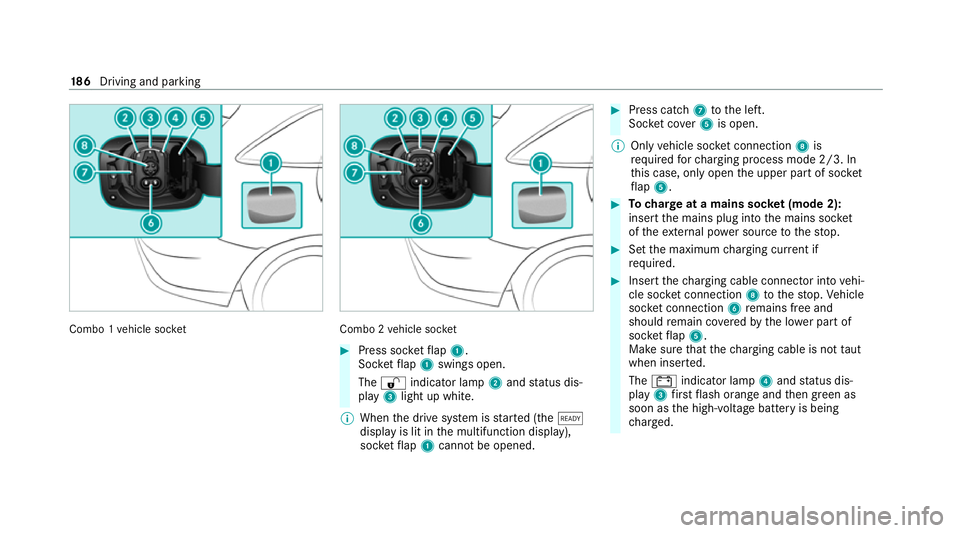
Combo 1
vehicle soc ket Combo 2
vehicle soc ket #
Press soc ketflap 1.
Soc ketflap 1 swings open.
The % indicator lamp 2and status dis‐
play 3light up white.
% When the drive sy stem is star ted (the õ
display is lit in the multifunction display),
soc ketflap 1 cannot be opened. #
Press cat ch7 tothe left.
Soc ket co ver5 is open.
% Only vehicle soc ket connection 8is
re qu ired forch arging process mode 2/3. In
th is case, only open the upper part of soc ket
fl ap 5. #
Tocharge at a mains soc ket (mode 2):
insert the mains plug into the mains soc ket
of theex tern al po wer source tothestop. #
Set the maximum charging cur rent if
re qu ired. #
Insert thech arging cable connec tor into vehi‐
cle soc ket connection 8tothestop. Vehicle
soc ket connection 6remains free and
should remain co veredby the lo wer part of
soc ketflap 5.
Make sure that thech arging cable is not taut
when inser ted.
The # indicator lamp 4and status dis‐
play 3firs tflash orange and then green as
soon as the high-voltage battery is being
ch arge d. 18 6
Driving and pa rking
Page 190 of 629
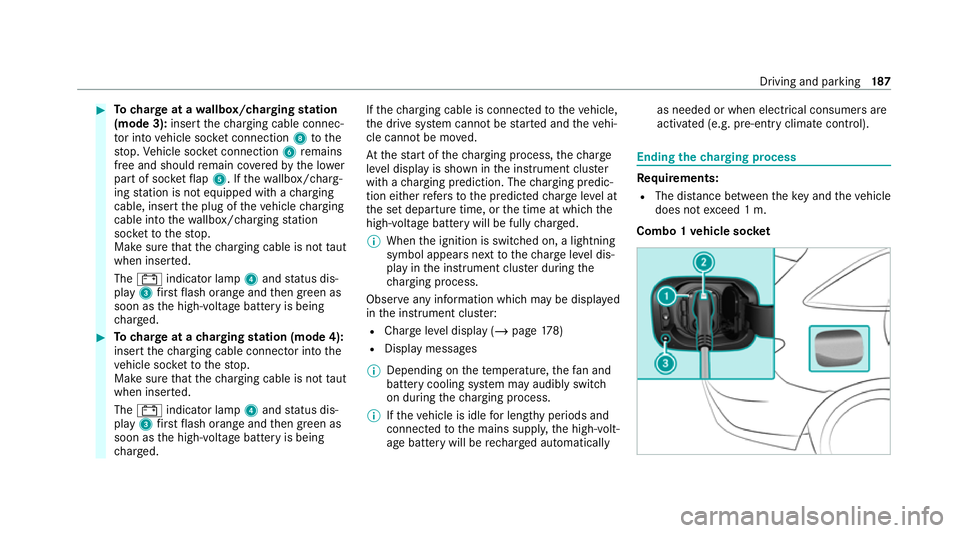
#
Tocharge at a wallbox/charging station
(mode 3): insertthech arging cable connec‐
to r into vehicle soc ket connection 8tothe
st op. Vehicle soc ket connection 6remains
free and should remain co veredby the lo wer
part of soc ketflap 5. If thewa llbox/ charg‐
ing station is not equipped with a charging
cable, insert the plug of theve hicle charging
cable into thewa llbox/ charging station
soc ketto thestop.
Make sure that thech arging cable is not taut
when inser ted.
The # indicator lamp 4and status dis‐
play 3firs tflash orange and then green as
soon as the high-voltage battery is being
ch arge d. #
Tocharge at a charging station (mode 4):
insert thech arging cable connec tor into the
ve hicle soc ketto thestop.
Make sure that thech arging cable is not taut
when inser ted.
The # indicator lamp 4and status dis‐
play 3firs tflash orange and then green as
soon as the high-voltage battery is being
ch arge d. If
th ech arging cable is connec tedto theve hicle,
th e drive sy stem cann otbe star ted and theve hi‐
cle cannot be mo ved.
At thest art of thech arging process, thech arge
le ve l display is shown in the instrument clus ter
with a charging prediction. The charging predic‐
tion either refers to the predicted charge leve l at
th e set departure time, or the time at which the
high-voltage battery will be fully charge d.
% When the ignition is switched on, a lightning
symbol appears next tothech arge leve l dis‐
play in the instrument clus ter during the
ch arging process.
Obse rve any information which may be displa yed
in the instrument clus ter:
R Char geleve l display (/ page178)
R Displ aymessa ges
% Depending on thete mp erature, thefa n and
battery cooling sy stem may audibly switch
on during thech arging process.
% Ifth eve hicle is idle for lengt hyperiods and
connec tedto the mains suppl y,the high-volt‐
age battery will be rech arge d automatically as needed or when elect
rical consumers are
acti vated (e.g. pre-entry climate control). Ending
thech arging process Re
quirements:
R The dis tance between theke y and theve hicle
does not exceed 1 m.
Combo 1 vehicle soc ket Driving and pa
rking 187
Page 261 of 629
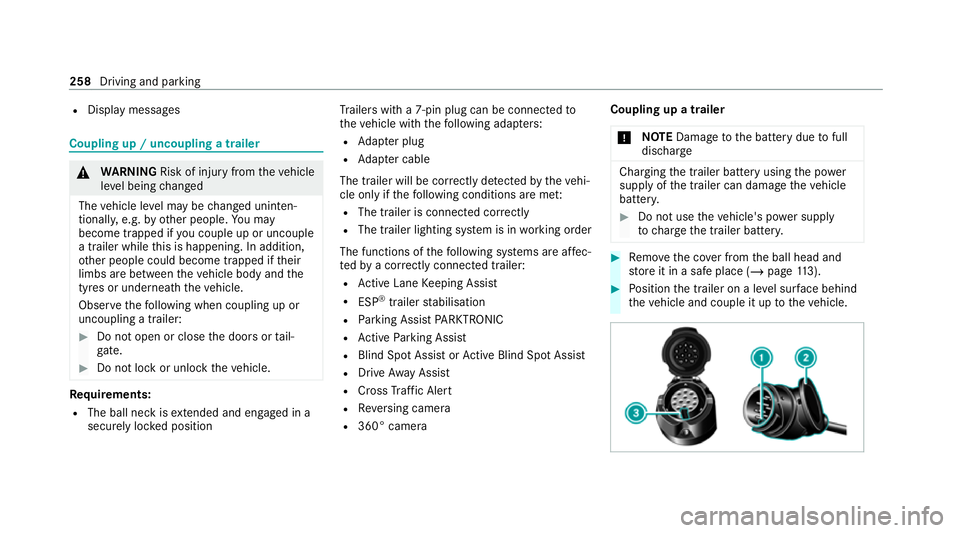
R
Displ aymessa ges Coupling up / uncoupling a trailer
&
WARNING Risk of inju ryfrom theve hicle
le ve l being changed
The vehicle le vel may be changed unin ten‐
tional ly, e.g. by other people. You may
become trapped if you couple up or uncouple
a trailer while this is happening. In addition,
ot her people could become trapped if their
limbs are between theve hicle body and the
tyres or undernea th theve hicle.
Obser vethefo llowing when coupling up or
uncoupling a trailer: #
Do not open or close the doors or tail‐
ga te. #
Do not lo ckor unlock theve hicle. Re
quirements:
R The ball neck is extended and engaged in a
secu rely loc ked position Tr
ailers with a 7-pin plug can be connec tedto
th eve hicle with thefo llowing adap ters:
R Adapter plug
R Adapter cable
The trailer will be cor rectly de tected bytheve hi‐
cle only if thefo llowing conditions are me t:
R The trailer is connected cor rectly
R The trailer lighting sy stem is in working order
The functions of thefo llowing sy stems are af fec‐
te dby a cor rectly connected traile r:
R Active Lane Keeping Assist
R ESP ®
trailer stabilisation
R Parking Assist PARKTRONIC
R Active Parking Assist
R Blind Spot Assist or Active Blind Spot Assi st
R Drive AwayAssi st
R Cross Traf fic Alert
R Reversing camera
R 360° camera Coupling up a trailer
* NO
TEDama getothe battery due tofull
dischar ge Charging
the trailer battery using the po wer
supply of the trailer can damage theve hicle
batter y. #
Do not use theve hicle's po wer supply
to charge the trailer batter y. #
Remo vethe co ver from the ball head and
st ore it in a safe place (/ page113). #
Position the trailer on a le vel sur face behind
th eve hicle and couple it up totheve hicle. 258
Driving and parking
Page 269 of 629
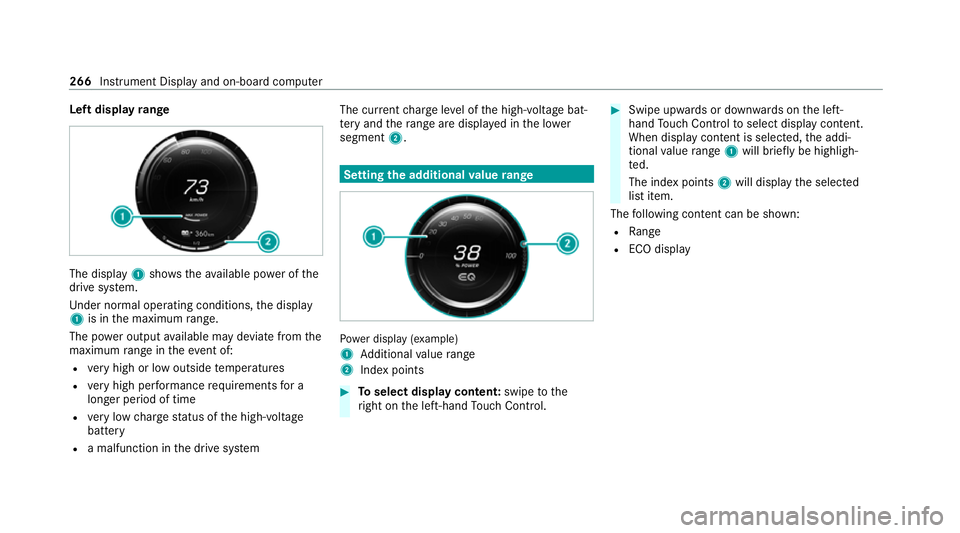
Left display
range The display
1showstheav ailable po wer of the
drive sy stem.
Und er normal operating conditions, the display
1 is in the maximum range.
The po wer output available may deviate from the
maximum range in theeve nt of:
R very high or low outside temp eratures
R very high per form ance requ irements for a
longer period of time
R very low charge status of the high-voltage
battery
R a malfunction in the drive sy stem The cur
rent charge leve l of the high-voltage bat‐
te ry and thera nge are displ ayed in the lo wer
segment 2. Setting the additional
value range Po
we r display (e xample)
1 Additional value range
2 Index points #
Toselect display content: swipetothe
ri ght on the left-hand Touch Control. #
Swipe upwards or down wards on the left-
hand Touch Control toselect display content.
When display content is selected, the addi‐
tional value range 1will brie fly be highligh‐
te d.
The index points 2will display the selected
list item.
The following con tent can be shown:
R Range
R ECO displ ay 266
Instrument Display and on-board computer